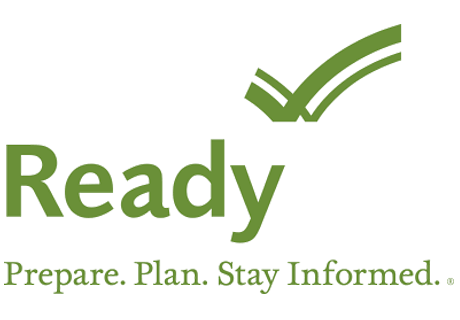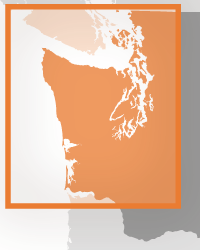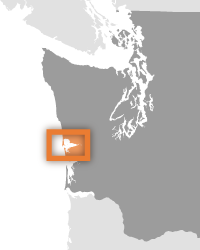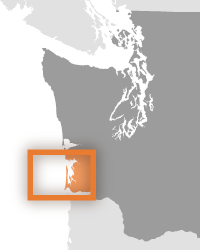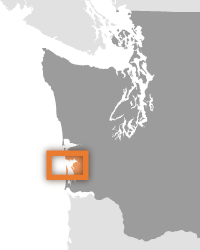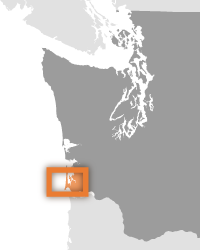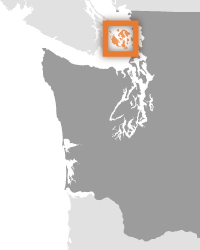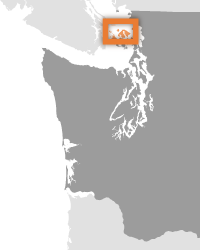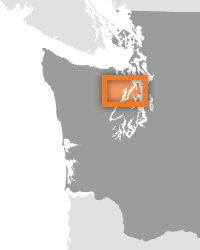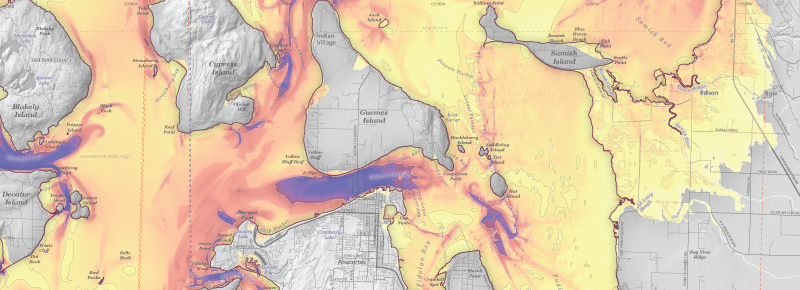
Tsunamis have hit Washington in the past, and they will happen again in the future. Click on the icons below to learn about how and where tsunamis occur, how to recognize a tsunami, how to evacuate before a tsunami arrives, and what geologists at the Washington Geological Survey are doing to learn more about these natural hazards.
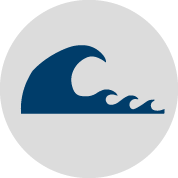 Understanding tsunamis |
 Tsunamis in Washington |
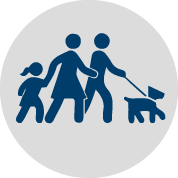 Preparation and evacuation |
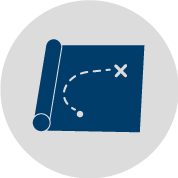 Tsunami evacuation maps |
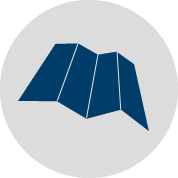 Tsunami hazard maps |
 Tsunami simulation videos |
 Tsunami alerts |
 Historical tsunamis worldwide |
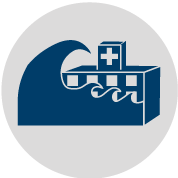 Building code design zone map |
Understanding tsunamis
In order to prepare for tsunamis we must first understand them. Knowing how tsunamis form, how they travel to reach shorelines, and how they behave once they are onshore gives us an idea of where they pose the greatest hazard.
- What is a tsunami
- What causes tsunamis
- Local and distant tsunamis
-
A tsunami is a powerful and destructive natural force. It’s a series of extremely long waves caused when an event, such as an earthquake, suddenly shifts water in the ocean or in a lake. A tsunami radiates outward in all directions from its source and can move across entire oceans in less than a day.
The speed of a tsunami depends on the depth of the water it’s traveling through. The deeper the water, the faster the tsunami. In the deep ocean, tsunamis are barely noticeable, but they can move as fast as a jet plane, more than 500 mph. As they enter shallow water near land, they slow to approximately 20 or 30 mph, which is still faster than a person can run.
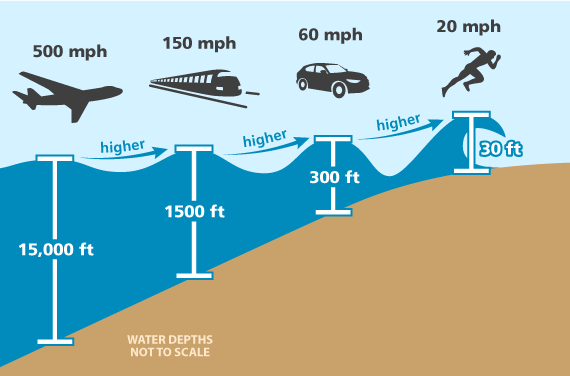
Speed of tsunami waves compared to common means of transportation. Figure modified from Japan Meteorological Agency.As tsunamis slow down, they grow in height. When they arrive on shore, most are less than 10 feet high. In extreme cases, they can exceed 100 feet when they strike near their source. Large tsunamis can flood low-lying coastal areas more than a mile inland.

This animation shows how waves get taller as they reach shallow water. Animation by Régis Lachaume.Not all tsunamis act the same. A small nondestructive tsunami in one place may be very large and violent a few miles away. This is because coastal areas have different beach slopes and different offshore and coastal geographical features, such as reefs, bays, and river mouths.
Unlike a common wind wave, tsunami waves have a long wavelength of many tens of miles. This makes tsunamis far more powerful. Wind waves, due to their short wavelength, often break onto the shore early and are highly turbulent. They generally do not travel very far inland.
Tsunami waves approach the shore as a rapidly rising flow or wall of water. A tsunami will not look like a normal wind wave. Sometimes, the bottom of the wave, the trough, will arrive first. When this happens, the water suddenly draws back, showing the ocean floor, reefs, and fish like a very low, low tide.
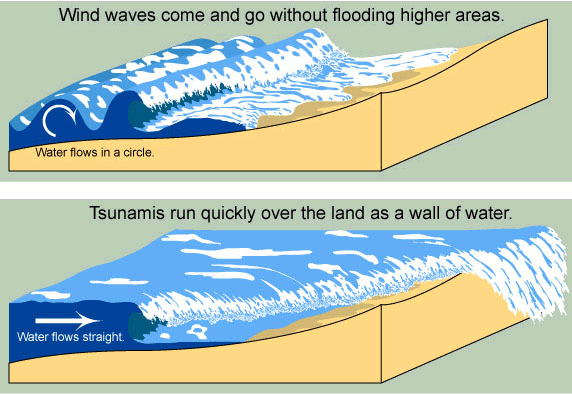
Wind waves break early and do not generally travel far inland. Tsunami waves do not break and can travel very far inland. Image by University of Washington.The time between waves ranges from five minutes to two hours. The first wave may not be the largest or the most damaging. Dangerous coastal flooding and powerful currents may last for several hours or days.
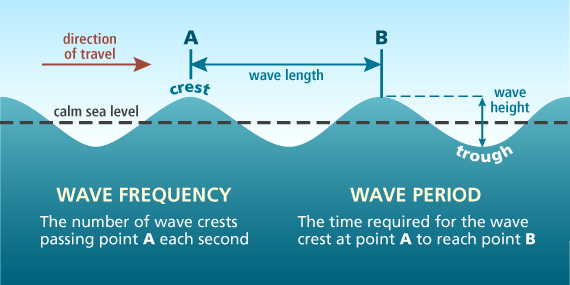
Components of a wave. Image modified from NOAA ocean service education.As shown in the video below, the first tsunami wave may not be the largest. In many parts of Japan during the 2011 Tohoku tsunami, the fifth wave was the largest. In the 1964 Alaska earthquake, the fourth wave was the largest to strike Crescent City. These waves will occur over a period of many minutes to hours. Evacuees should remain in a safe high ground location and not return to low-lying areas until directed to do so by emergency management.
This video shows the arrival of a tsunami in a coastal community of Japan after the 2011 Tohoku earthquake. The tsunami arrives over several minutes and flows straight over the land, flooding buildings up to their second story.
Seiches
A seiche is a standing wave that can form in enclosed bodies of water such as lakes, bays, and even swimming pools. When seismic waves shift shorelines during an earthquake, this movement pushes the water toward one side of the basin. The water then begins to slosh back and forth. This type of wave is particularly damaging for inland lakes such as Lake Union, and is prevalent in areas around the Puget Sound.
Seiche recorded in a swimming pool during an earthquake in Baja California, 2010.
-
The most common cause of a tsunami is a large earthquake below or near the ocean floor. Landslides, volcanic activity, certain weather conditions, and space objects, such as meteorites can also generate tsunamis. Most of the tsunamis (88%) in the Global Historical Tsunami Database were generated by earthquakes or landslides caused by earthquakes.
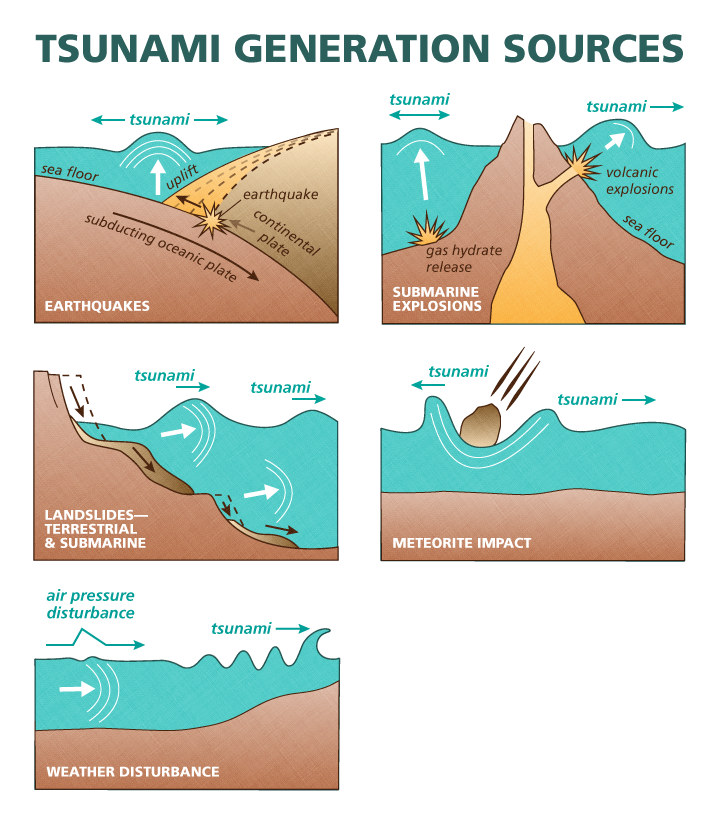
Image partially modified from a diagram by Adam Switzer.Earthquakes
Not all earthquakes generate tsunamis. Whether an earthquake generates a tsunami or not depends on key characteristics like the location, magnitude, and depth of the earthquake. In general, earthquakes that generate tsunamis:
- Occur under the ocean or near shorelines (usually at or near subduction zones, where oceanic and continental plates collide).
- Have magnitudes of more than 7.0 (usually, an earthquake must exceed magnitude 8.0 to generate a dangerous distant tsunami).
- Are triggered less than 100 kilometers (62 miles) below Earth’s surface.
As these details are generally not known immediately following an earthquake, you should always evacuate from coastal areas when any strong shaking is felt.

Tohuku 2011 earthquake-generated tsunami overtopping harbor seawall. Image from the New York Times.Earthquake Sources
Washington has three major earthquake sources that have the potential to cause tsunamis: subduction zone earthquakes, deep (Benioff Zone) earthquakes, and shallow crustal fault earthquakes.

Sources of earthquakes in Washington and the relative frequency of occurrence. Deep (Benioff zone) earthquakes do not produce tsunamis. However they may trigger landslides that could generate tsunamis. Image adapted from USGS.Cascadia subduction zone earthquakes
The Cascadia subduction zone off the coast of Washington, British Columbia, Oregon, and northern California is the biggest tsunami hazard for Washington State. This very large fault is capable of generating some of the largest and most damaging earthquakes in the world. These earthquakes also cause very large and damaging tsunamis. The following series of diagrams shows how tsunamis are created along the Cascadia subduction zone.
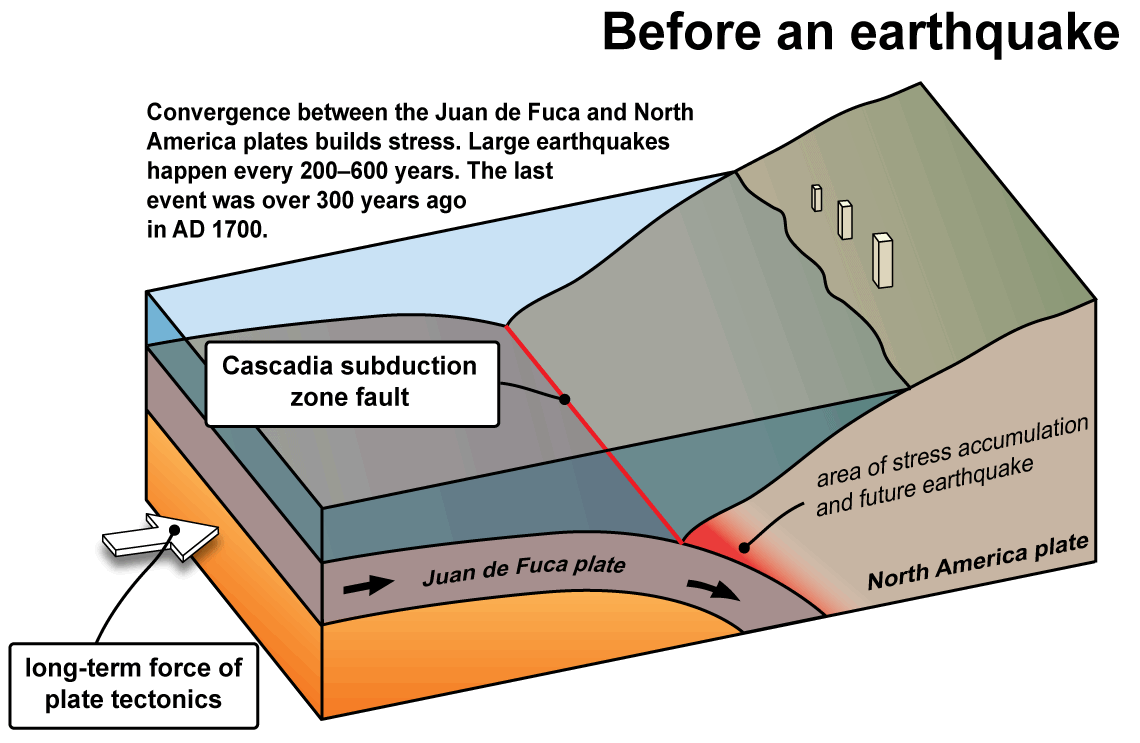
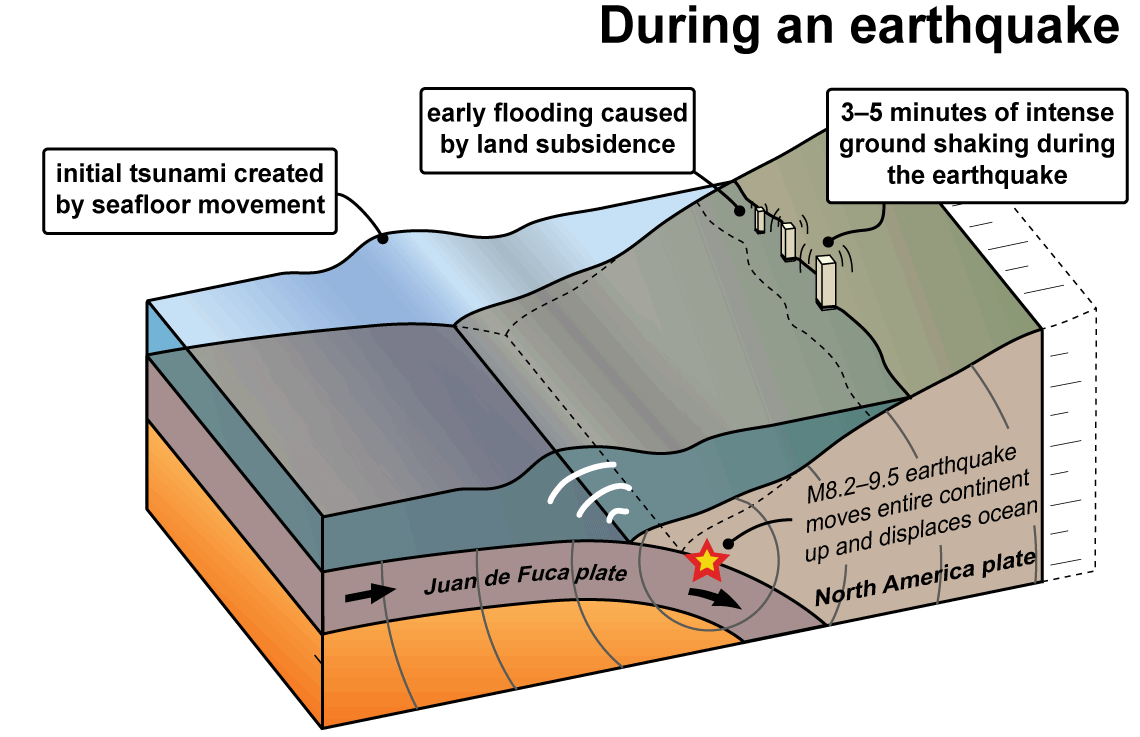
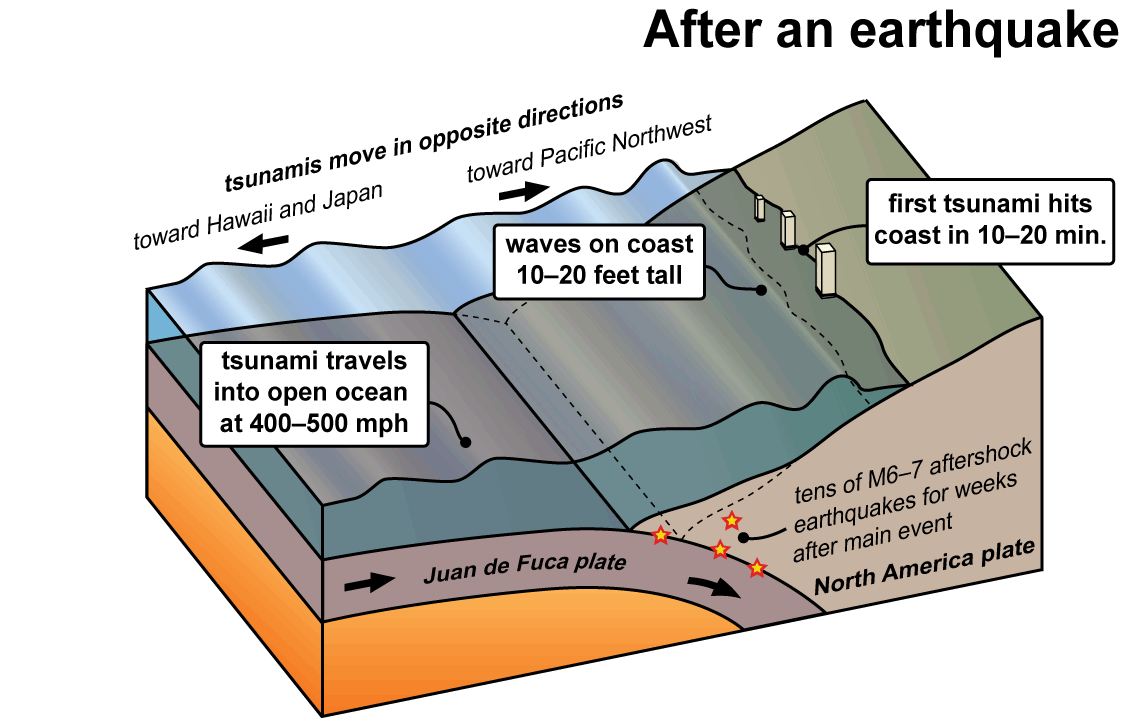
Schematic diagram of the sequence of events in a Cascadia Subduction Zone earthquake. Areas uplifted offshore will create a tsunami wave that will inundate coastal areas that have already subsided from the earthquake.
Zones of uplift and subsidence during a Cascadia subduction zone earthquake. Image modified from a diagram by Carrie Garrison-Laney (WA SeaGrant).
Crustal Faults
Other faults in Washington, such as the Seattle Fault, can also move the ocean floor and cause tsunamis. The Seattle Fault is known to have had an earthquake event that directly produced a tsunami (see Atwater and Moore, 1992), and other crustal faults (Tacoma Fault and Darrington-Devils Mountain fault zone, for example) could produce tsunamis (Williams and others, 2000).
Additionally, there are numerous landslide-generated tsunami deposits that were triggered by local earthquakes found throughout the Puget Sound. For this reason we consider all active crustal faults that are near to Puget Sound to be a possible direct or indirect source of future tsunamis. Models for tsunami inundation in parts of the Puget Sound exist for the Seattle and Tacoma faults and can be found on our Geologic Information Portal.
Distant Events
Tsunamis generated from earthquakes at other subduction zones and faults around the Pacific Ocean have the potential to impact our shores. Of the numerous historical events that have occurred, only the 1964 Alaska earthquake-generated tsunami has caused damage to the Washington coast. Most tsunami alert messages received for Washington are related to earthquakes in Alaska. You can read more about the impacts of the 1964 Alaska tsunami here.
Landslides
Rock falls, slope failures, debris flows, and slumps are all types of landslides. Icefalls, avalanches, and glacial calving (the breaking off of large pieces of ice from a glacier) can also cause tsunamis.
Tsunamis can be generated when a landslide displaces water. Whether a tsunami is created depends on the amount of landslide material, the speed at which the material is moving, and the depth the material reaches. Near its source, a landslide-generated tsunami may be larger than a tsunami generated by an earthquake, and it can affect nearby coasts within minutes with little to no warning. These tsunamis usually lose energy quickly and rarely affect distant coasts.
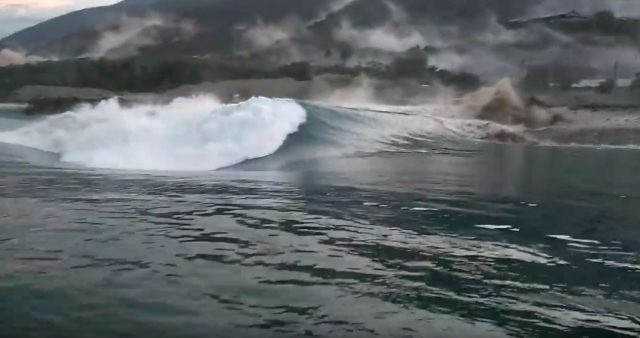
Tsunami wave suspected to be generated by a submarine landslide in the 2018 Sulawesi earthquake, Indonesia. Notice the abundant dust plumes in the background from landslides on land. Image from The Landslide Blog.Volcanic Eruptions
When volcanoes erupt under water or near shorelines, the eruption can displace water, causing a tsunami. Several types of volcanic activity can displace enough water to generate destructive tsunamis, including the following:
- Pyroclastic flows (flowing mixtures of rock fragments, gas, and ash).
- Submarine eruptions near the ocean surface.
- Landslides (such as the collapse of the flank of a volcano).
- Lateral blasts (sideways eruptions). Like landslide-generated tsunamis, tsunamis generated by volcanic activity usually lose energy quickly and rarely affect distant coasts.
Oregon State University maintains a list of noteworthy tsunamis triggered by volcanoes.
Bolide (meteorite) impacts
If large objects from space hit earth, they can displace water and cause a tsunami. To date, no asteroid impact-generated tsunamis have been recorded during historical times. There is evidence that such events may have happened in the geologic past. The most well-known example is the Chicxulub impact 65 million years ago.
Weather
Tsunamis can even be caused by weather changes. Air pressure disturbances often associated with fast-moving weather systems, like lines of active thunderstorms, can generate tsunamis. Their development depends on the intensity, direction, and speed of the air pressure disturbance as it travels over a water body.
Most meteotsunamis are too small to notice, but large meteotsunamis can bring dangerous waves, flooding, and strong currents that can cause damage, injuries, and deaths. Meteotsunamis are also regional, meaning they don’t affect entire coastlines or bodies of water.
The deadliest known meteotsunami on record occurred on June 26, 1954, on Lake Michigan, Illinois when an approximately 15-foot wave fatally swept seven people off a pier.
-
The difference between a local and distant tsunami is the distance between a tsunami’s source (where the land moved to generate the tsunami) and where the wave may strike land.
A local tsunami, also called a local-source or near-field tsunami, is from a nearby source and may arrive in less than one hour, sometimes in just minutes. Local tsunamis pose the greatest threat because tsunamis are most damaging near their source and there is little time to issue official warnings and evacuate.
The public must know how to recognize and respond to natural tsunami warnings, such as ground shaking from an earthquake. Examples of local tsunami threats in Washington are tsunamis generated from earthquake events on the Cascadia subduction zone or local crustal faults such as the Seattle or Tacoma faults.
A distant tsunami, also called a distant-source tsunami, a far-field tsunami, or a tele-tsunami, is from a faraway source, sometimes on the other side of the ocean. This means there is more time to issue and respond to official warnings (usually at least three hours).
Tsunamis in Washington
If you’ve been to beaches and coastal communities in the Pacific Northwest, you’ve probably seen signs like these:
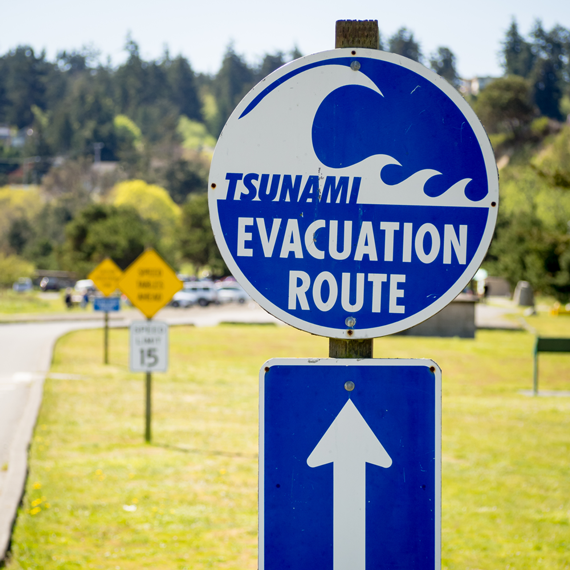 |
 |
These signs tell you that you are in a place that is especially at risk for tsunamis. Washington has the second highest seismic risk in the United States (behind California) due to the presence of numerous crustal faults and a subduction zone offshore.
There are four main types of tsunami risk in Washington. Each type affects different parts of the State. Emergency planners and hazard geologists are working hard to learn more about these risks.
| Types of tsunami risk | |||
|---|---|---|---|
| Type of tsunami | Description | Area of greatest impact | Time to evacuate |
| Distant | A tsunami is created by a distant earthquake or landslide and travels across the ocean | Pacific coastal communities | Hours |
| Cascadia subduction zone | Tsunami created by large Magnitude 8–9 earthquake off the Washington, Oregon, or British Columbia coasts | Pacific coastal communities | Tens of minutes |
| Local earthquake (for example, the Seattle or Tacoma faults) | Tsunami created in large body of water from an earthquake on local faults | Communities close to the body of water | Minutes to tens of minutes |
| Landslide-caused tsunami | Large landslide occurs underwater or slides from land into water | Depends on where the landslide occurs | Minutes to tens of minutes |
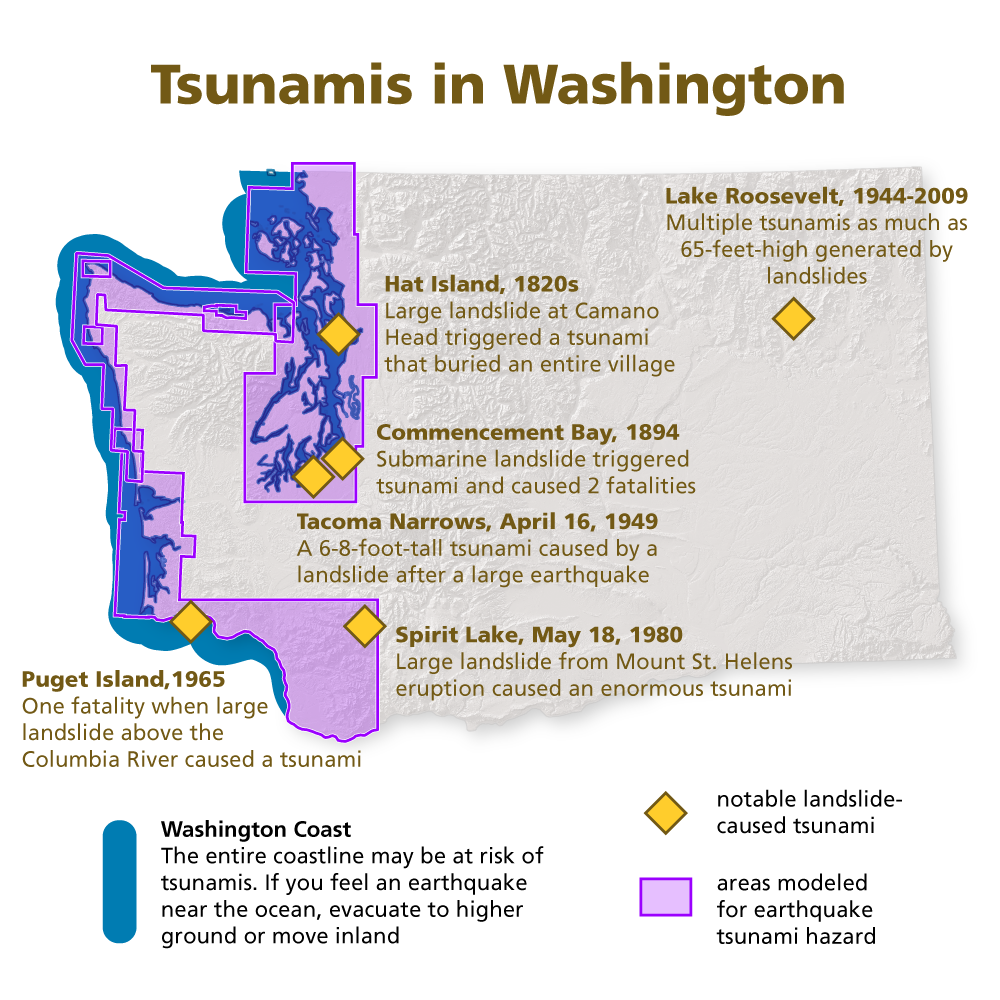
Above is a map of notable locally derived tsunamis that have occurred in Washington during historic times. All fatalities from tsunamis in the State have originated from landslides sources. Some of these landslides were triggered by preceding earthquakes and others have occurred with no clear trigger.
Evidence of past earthquakes and tsunamis
For an earthquake to produce a tsunami, a rapid, large change in the elevation of the ocean floor must occur. These land-level changes are known as uplift if the earth surface rises and subsidence if the earth surface falls. Some examples of land level change are Restoration Point in Seattle, where the 900 AD Seattle Fault earthquake uplifted the land surface by 23 feet (Bucknam and others, 1992).
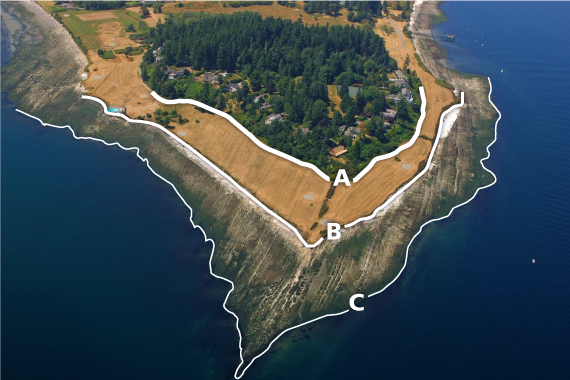
Restoration Point in Seattle, with different shorelines showing the sudden uplift that occurred during the 900 AD Seattle Fault earthquake. (A) The shoreline before the earthquake happened. (B) The current-day shoreline. (C) The shoreline after the earthquake lifted up the land. Photo adapted from USGS.
There are also “ghost forests” on the outer coasts of Washington and Oregon. These forests represent locations where trees were killed when the land suddenly dropped during a major earthquake. Tree ring dating, or dendrochronology, places the death of these trees in the winter of 1699–1700, the same time that the last Cascadia subduction zone earthquake occurred.

Dead cedar snags along the Copalis River. Here the land subsided several feet during the 1700 Cascadia subduction zone earthquake.
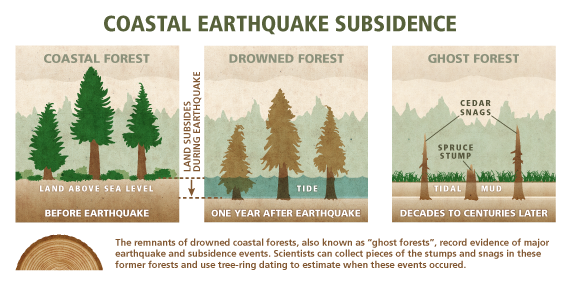
Illustrated example of how earthquake subsidence leads to tree death, followed by sediment deposition. Image modified from a diagram by Brian Atwater, USGS.
When tsunamis inundate a coastline, they may leave behind distinct sediment deposits. These deposits are typically layers of sand and other debris that are carried up and deposited on land by the force of the tsunami waves. These deposits are found in marshes and near-tidal areas where the sand gets trapped in the root systems of plants. The thicknesses of these deposits reflect the size of the tsunami and the probable tsunami source.
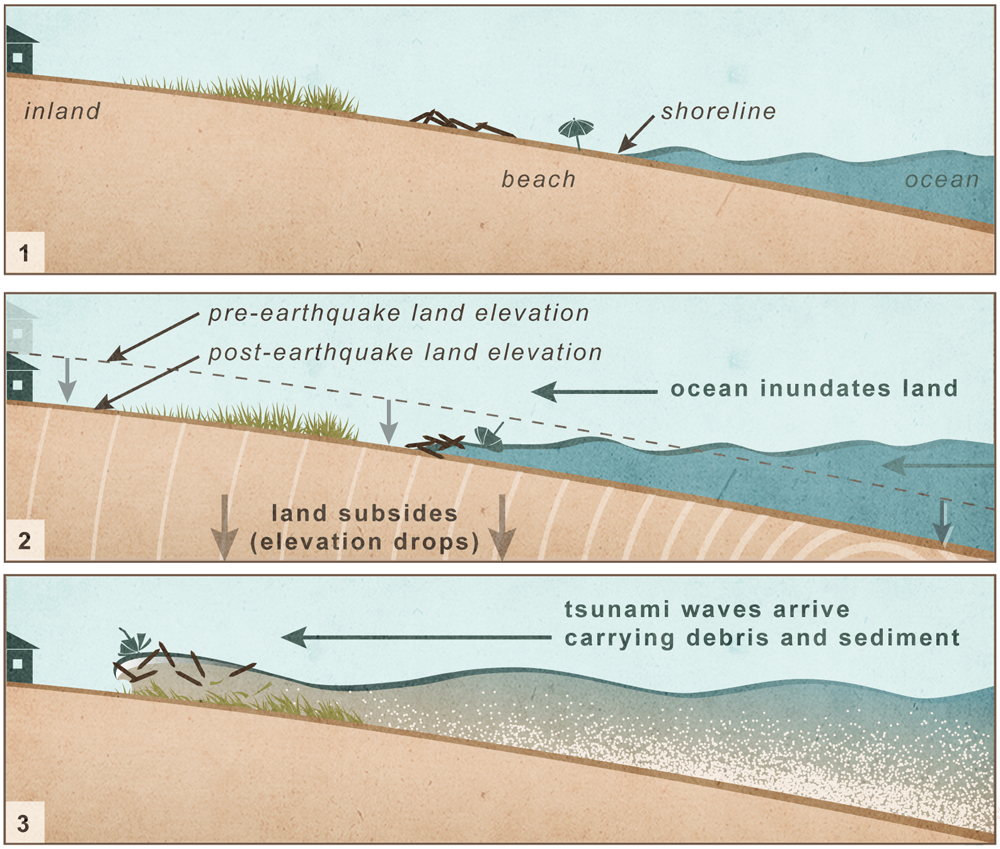
Diagram of how tsunami deposits are created.
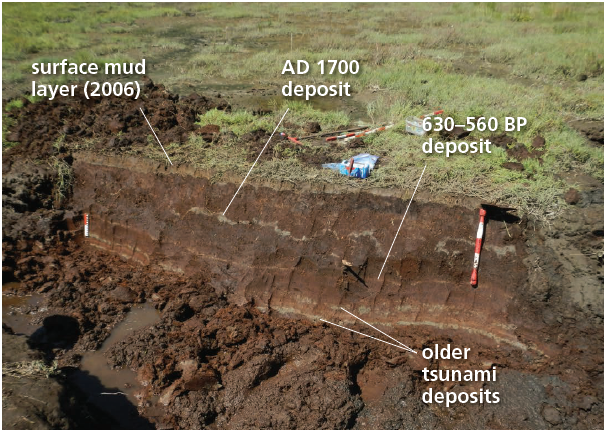
Photo of tsunami deposits (sand layers with silty clays above and below) at Discovery Bay, WA. Four tsunami deposits visible in photo include an inferred AD 1700 sand layer that was later disturbed by marsh restoration projects, a sand layer dated at 630 to 560 radiocarbon years BP (Garrison-Laney and Miller, 2017), and two older sand layers beneath. The topmost mud layer was deposited in 2006, following marsh restoration. Photo by Carrie Garrison-Laney (Washington Sea Grant).
The map below shows the locations of tsunami deposits along the Pacific Northwest coastline. Deposits found on the outer coast are dominantly from the Cascadia subduction zone, while those within Puget Sound are typically from local crustal faults such as the Seattle fault.
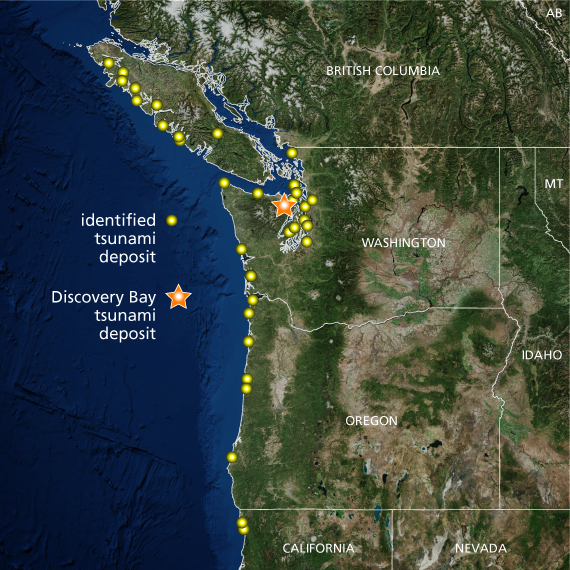
Locations of identified tsunami deposits. Figure adapted from a map by Carrie Garrison-Laney (WA Sea Grant).
Preparation and evacuation
It is important to know the warning signs of a tsunami. Know what to expect. Know what to do.
For people in Washington, the single biggest warning of a potential tsunami is a large earthquake.
If you are near the ocean or in Puget Sound when there is a large earthquake or there is a tsunami warning, EVACUATE TO HIGHER GROUND!

Be aware that a tsunami may be coming if you:
- Hear a tsunami warning siren or receive a tsunami alert.
- Feel a strong earthquake near the ocean or a large lake. A strong earthquake is one that knocks people down, damages buildings, or lasts for longer than 20 seconds.
- Notice a very large wave approaching.
- See coastal waters recede. As the tsunami approaches, sometimes sea level will drop rapidly as the wave gets taller.
- Notice an unusually rapid rise in sea level. Some tsunamis will have a surge in front of them as they approach land. These surges can be very damaging and dangerous.
- Notice a landslide that falls or slides into the ocean, a large lake, or a river.
If you notice any of these signs or hear a tsunami warning, EVACUATE IMMEDIATELY!
- Personal preparedness
- Maritime preparedness
- Vertical evacuation
- Apps for mobile devices
- Other resources
-
It’s easy to prepare for a tsunami. Many of the things you should do to prepare for a tsunami are the same as those for other hazards in your community. If your home, school, workplace, or other places you visit often are in tsunami hazard zones, you should do the following:
- Ensure you have multiple ways to receive warnings. Get a battery-operated NOAA Weather Radio, sign up for text message alerts from your local government, and make sure your mobile devices are set to receive emergency alerts.
- Make an emergency plan that includes plans for family communication and evacuation. Practice your plan and keep it up to date.
- Map out routes to safe places on high ground or inland (away from the water). Your community may already have identified evacuation routes and assembly areas. Plan to evacuate on foot if you can; roads may be impassable due to damage, closures, or traffic jams. If you don’t think you would be able to reach a safe place in time, ask your local emergency management office about vertical evacuation. Some strong buildings, such as those made of reinforced concrete, may be able to provide protection if no other options are available.
- Practice walking your routes, even in darkness and bad weather. This will make evacuation quicker and easier during an emergency.
- Put together a portable disaster supply kit with items you and your family (including pets) may need in an emergency. Since you do not know where you’ll be when disaster strikes, prepare kits for work and cars, too. Consider storing supplies with family or friends outside of the tsunami hazard zone. Washington State Emergency Management recommends that each person prepare to be 2-Weeks Ready. Some coastal areas have additional recommendation for 30-day preparedness.
- Be a role model. Share your knowledge and plans with friends and neighbors so they can prepare themselves and their loved ones.
- If you have children in school in a tsunami hazard zone, find out the school’s plans for evacuating children and keeping them safe. Find out where the assembly area is and where to pick up your children after the danger has passed.
- If you’re visiting the coast, find out about local tsunami safety. Your hotel or campground should have this information.
Are you tsunami ready? This video provides tsunami preparation tips for the Washington coast.
-
If you’re a boat owner or captain, you should take extra steps to prepare for a tsunami:
- Make sure you have a way to receive tsunami warnings when you’re on the water. The U.S. Coast Guard will issue urgent marine information broadcasts on your marine VHF radio’s channel 16. Additional information will be available from NOAA Weather Radio.
- Find out what to do in your area if you get a tsunami warning when you’re on a boat. Your harbormaster, port captain, the U.S. Coast Guard, and local, state, and territory emergency management offices are the best sources for tsunami safety information and regulations for boaters in your area.
- Make a plan and put together a disaster supplies kit to keep onboard. Be aware that shore facilities may be damaged, so if you’re at sea during a tsunami, you may not be able to return to harbor. Be prepared to remain at sea for a day or more. In general, the following recommendations apply if you get a tsunami warning:
- If you’re in a harbor, you should leave your boat and move quickly to a safe place on land (high ground or inland, away from the water).
- If you’re at sea, you should move to a safe depth (safe depths vary by region, but the minimum safe depth is 30 fathoms—180 feet) and stay away from harbors under warning until officials tell you the danger has passed.
-
We work with the WA Emergency Management Division (EMD) and local communities to facilitate the planning and design of tsunami evacuation structures. The first vertical tsunami evacuation structure in North America was built as part of a new elementary school in the Ocosta School District at Westport. The evacuation structure is designed to hold 1,000 people above the gymnasium. The surrounding area has little high ground for other types of evacuation.
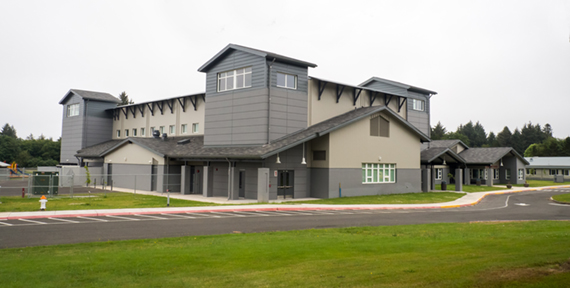
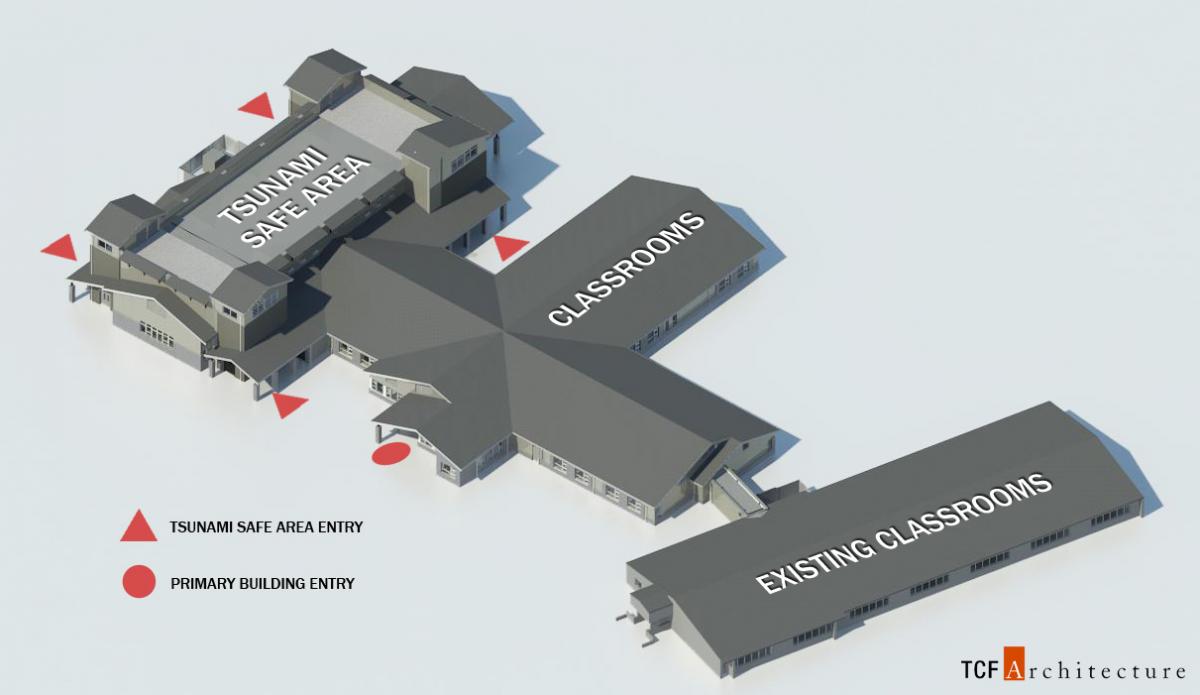
The Ocosta School vertical evacuation structure.Numerous other communities along the Washington coast are in the planning or proposal process to build vertical evacuation structures. For more information about building an evacuation structure in your community see the Manual for Tsunami Vertical Evacuation Structures developed by WA EMD.
-
A mobile app from NANOOS allows you to access maps on your smartphone or tablet. Use your device’s location detection feature to find yourself on a map and plan for evacuation from your current location. NOTE: Earthquakes may damage the cellular network, preventing data use during an actual event. For this reason you should know and plan your evacuation ahead of time.
The most important thing you can do is to be informed and prepared. Visit these sites for additional information:
TsuInfo
Washington Emergency Management
Ready.gov
National Tsunami Warning System
National Tsunami Hazard Mitigation Program
Tsunami evacuation maps
Tsunami evacuation routes were developed to assist coastal residents and visitors in finding safer locations in case of an earthquake and tsunami. The Survey works with the Washington Emergency Management Division and local, county, tribal, and other planners and emergency managers to develop, publish, and distribute evacuation maps. These maps are made for areas that are especially at risk for damaging tsunamis.
Evacuation Maps
This map shows all completed tsunami evacuation brochures and walk time maps for Washington. Clicking on a region will show you a link where you can download the brochure or map. Use your scroll wheel or the plus and minus buttons in the upper left corner to zoom.
New tsunami evacuation walk time maps published September, 2023
Sign up for our WA geology blog to get updates on when new tsunami evacuation maps are released.
Click on the areas of the map below to view and download walk time maps (in purple) and evacuation brochures (in green).
Click here to open the map in full screen.
Evacuation Brochures
Tsunami evacuation brochures are single sheets providing general information about tsunami evacuation. They show tsunami inundation extent, evacuation routes, and points of interest. They also contain basic information about tsunami evacuation and preparedness, and local emergency management contacts.
Walk Time Maps
Tsunami evacuation walk time maps show a more detailed view of the time it would take to evacuate on foot from the tsunami inundation zone. The maps also show how long it would take for the first tsunami wave to arrive. Emergency managers, planners, and local decision makers use these maps to plan evacuation routes, put in place critical resources, and plan response. The public should use these maps before the tsunami occurs, by learning the routes ahead of time for home, work, and school.
How are Walk Time Maps Created?
The evacuation walk time maps are created from models that use the Pedestrian Evacuation Analyst Toolkit (PEAT). This toolkit was developed by the U.S. Geological Survey to aid in evacuation planning for natural hazards. The tool uses elevation changes and type of land cover to calculate walking speed along the evacuation route. Areas with steeper terrain or heavy vegetation will take longer to cross. The colors on the map show readers how long it takes to walk to high ground. The Washington Geological Survey works closely with each community’s emergency management and government representatives to determine the evacuation routes, shelters, and points of reference shown on each map.
What Walk Time Maps Can’t Tell Us
Walk time maps cannot predict the impacts of earthquakes, such as damage to buildings or infrastructure. During an earthquake, power lines may topple, underground utilities may rupture, and the ground may settle or shift. These unpredictable effects may slow evacuation time.
The maps also assume a slow walk pace (2.5 mph). Not everyone travels at this pace, especially during an emergency. Determine how the times shown on the map compare to your own walking pace. This will give you a better estimate of how long it would take you to get to high ground.

Want to know if your house or neighborhood is at risk? Check out our Geologic Information Portal and type in your address to see if a tsunami evacuation map is available in your area.
| Click the map icon to see tsunami content on the Geologic Information Portal. |
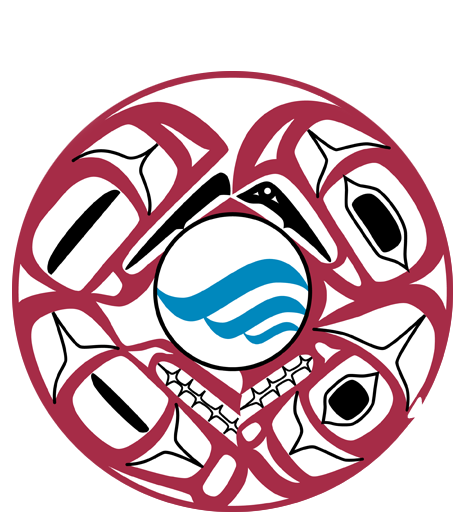 |
The Northwest Association of Networked Ocean Observing Systems (NANOOS) has developed an interactive map of tsunami evacuation zones, routes, and assembly areas for both Oregon and Washington. |
Tsunami hazard maps
Looking for our new publication about the Seattle Fault earthquake and tsunami? Click here to download it.
The mission of the Washington Geological Survey (WGS) is to collect, develop, use, distribute, and preserve geologic information to promote the safety, health, and welfare of the citizens, protect the environment, and support the economy of Washington. In order to do this, WGS works with the National Oceanic and Atmospheric Administration (NOAA) and the University of Washington to model the inundation (flooding) of coastal areas from tsunamis.
These inundation models are based on the shape of the ocean floor, the topography of the land, and the expected size and shape of tsunami waves. These properties are derived from what we know about past earthquakes and tsunamis that are found in the geologic record of the Pacific Northwest. The result of the modeling is a series of maps that show the expected depth of water and the speed of the currents from an earthquake-generated tsunami.
The inundation and current velocity maps and publications can be downloaded by clicking on the area of interest in the maps below. You can also download the model data by clicking on the area of interest. You can use your scroll wheel or the plus and minus buttons in the upper left corner to zoom. Sign up for our WA geology blog to get updates when new tsunami hazard maps are released.
Tsunami hazards from a Cascadia magnitude 9 earthquake scenario:
Tsunami hazards from a Seattle Fault earthquake scenario:
Our most recent modeling for a Tacoma fault earthquake scenario dates back to 2009. Click here to download the publication. Note that this publication also contains modeling for a Seattle Fault earthquake scenario. Those results have been superseded by Map Series 2022-03, available by clicking on the map above.
Geologic Information Portal
All Washington coastlines and major lakes are at risk from tsunamis. Want to know if your house or neighborhood is at risk? Check out our Geologic Information Portal and type in your address to see if tsunami inundation has been mapped in your area. Please note that not all coastal communities have been mapped for tsunami hazards.
| Click the map icon to see tsunami content on the Geologic Information Portal. |
Other hazard products
Check out the Risk Visualization Viewer, a collaborative effort between FEMA and WGS. The viewer shows tsunami inundation and river flood models in a 3D visualization for the cities of Aberdeen, Hoquiam, and Cosmopolis. The visualization is best viewed in full screen.
Tsunami simulation videos
Modeled tsunami wave amplitudes for the Washington coast following a Cascadia subduction zone magnitude 9.0 earthquake scenario.
Tsunamis are multi-wave events that affect coastal areas for many hours to potentially days after an earthquake happens. In order to show how tsunamis might affect a certain area over time we use computer models to simulate how tsunami waves might behave for a given earthquake scenario. Videos of tsunami simulations show tsunami wave behavior in a way that is difficult to convey through static images and maps.
For more detailed tsunami wave heights for your area and for more information about tsunami inundation modeling, refer to our tsunami hazard maps.
Note that these videos are for informational purposes only and should not be used for site-specific decision-making.
Use the links below to view or download the videos for your area of interest. The videos are available on YouTube, or as downloadable zipped MP4 files.
Modeling for a Seattle Fault earthquake scenario
 |
Southern Bainbridge Island and Portions of the Kitsap Peninsula Tsunami Current Velocity |
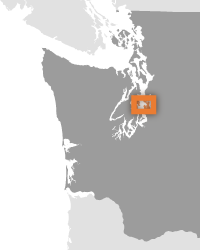 |
Seattle–Bainbridge Island Waterfronts Tsunami Current Velocity |
 |
Central Puget Sound Tsunami Current Velocity |
Modeling for a Cascadia magnitude 9 earthquake scenario
Tsunami alerts
How will you know if a tsunami could be approaching? For people in Washington, the single biggest warning of a potential tsunami is a large earthquake. Once a tsunami has been created, there is usually a delay of several minutes to hours before it reaches land, depending on distance from the earthquake source. Scientists also use networks of ocean sensors to detect and monitor tsunamis.
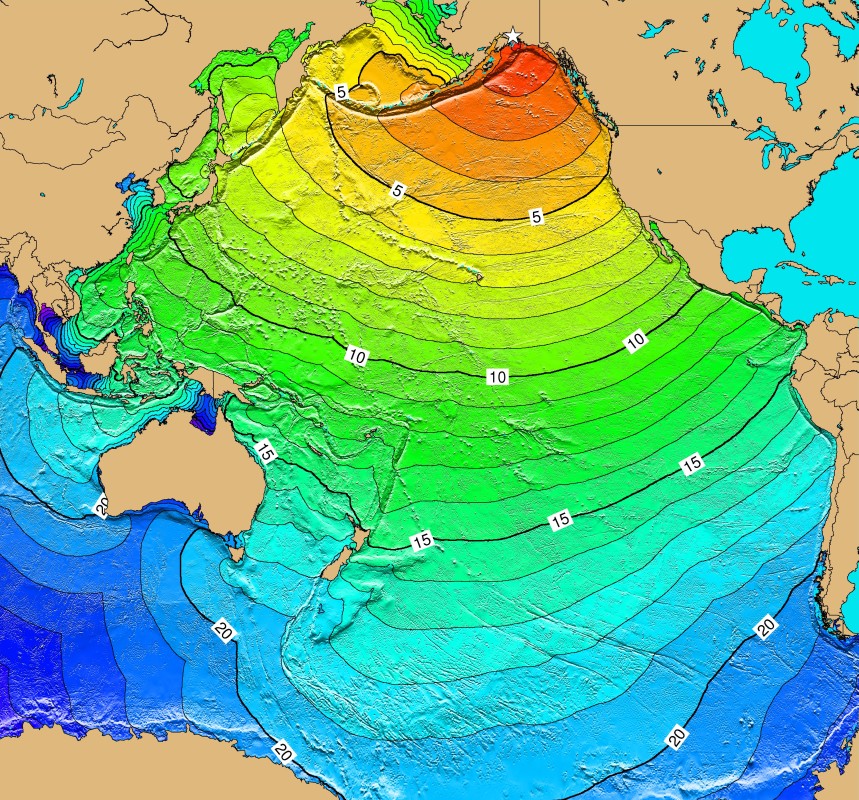
Example of a Tsunami travel time map from the 1964 Alaska Earthquake. In this event the first wave reached Washington in approximately four hours. Image by NCEI.
The U.S. Tsunami Warning System is a system led by NOAA that operates in partnership with other local, state, federal, territorial, and international organizations as well as private industry. The system uses observation networks to detect and measure earthquakes that could generate tsunamis. The networks also allow us to monitor the tsunamis once they have been generated.
Washington State is served by the National Tsunami Warning Center (NTWC). Staffed 24 hours a day, seven days a week, this center monitors the observation networks, analyzes events as they occur, and if necessary provides advanced warning in case of a tsunami threat to the Washington Coast. Information provided by these networks helps them determine when and where to issue tsunami messages.
- Seismic networks—When an earthquake occurs, networks of seismic stations such as the Global Seismographic Network (GSN), and the Pacific Northwest Seismic Network (PNSN) provide information about an earthquake’s location, depth, magnitude, and other characteristics. The warning centers analyze this information to determine if tsunami messages are necessary.
- Water-level networks—If an earthquake meets certain criteria, the warning centers use information about water-level changes to determine if a tsunami has been generated and, if so, its size. The primary sources of information about water-level change are a network of deep ocean sensors (known as DART) and coastal water level stations.
- Coastal water-level stations collect important information about ocean height at specific coastal locations. The warning centers use this information to confirm tsunami arrival time and height and incorporate these findings into tsunami forecast models.
Warning people about tsunamis
In the U.S., tsunami warnings occur through the Emergency Alert System. In some beach communities, there are loud sirens that warn of a potential tsunami. You can subscribe to SMS, email, or phone notifications. Radio, television, and internet warning systems also exist. Contact your local emergency manager to ask about tsunami alert information for your area.
Although substantial loss of life can occur with any major tsunami, people who are warned ahead of time are better prepared to survive. Different types of alerts let people know what actions need to be taken once they receive the alert.

Alert and Warning levels issued by the National Tsunami Warning Center (NTWC). Image modified from WA Emergency Management Division.
Tsunami Warning
A tsunami warning is issued when a tsunami with the potential to generate widespread inundation is expected or currently approaching. Warnings alert the public that dangerous coastal flooding accompanied by powerful currents is possible and may continue for several hours after initial arrival.
Tsunami Advisory
A tsunami advisory indicates if a tsunami is expected or currently approaching, but differs from a warning in that the tsunamis waves are not expected to be as high. People are advised to stay away from the coast. The threat of a tsunami may still continue for several hours after initial arrival.
Tsunami Watch
A tsunami watch is issued when a tsunami may later impact the watch area. The watch may be upgraded to a warning or advisory or canceled based on updated information and analysis. Emergency management officials and the public should prepare to take action.
Information Statement
A tsunami information statement is issued when an earthquake or tsunami has occurred that may be of interest to coastal residents. In most cases, information statements indicate there is no threat of a destructive basin-wide tsunami and that evacuation is unnecessary at the present time.
Historical tsunamis worldwide
The list below shows a selection of major tsunamis with notable scientific or cultural impact that have happened in recorded history.
| Some Historical Tsunamis | |||||
|---|---|---|---|---|---|
| Name | Date | Original location | Maximum wave height | Type of tsunami | Size of earthquake |
| Sulawesi | Sept. 28, 2018 | Indonesia | 23 feet | Earthquake | M7.5 |
| Notes:A shallow earthquake caused a tsunami that hit coasts locally in the Sulawesi area. The earthquake caused major soil liquefaction, leading to mudflows. The combined tsunami and earthquake caused more than 4,300 deaths. | |||||
| Sunda Strait | Dec. 22, 2018 | Indonesia | 43 feet | Volcanic landslide | None |
| Notes: The eruption and collapse of the volcano Anak Krakatau triggered a tsunami that killed nearly 430 people. The tsunami was not detected by warning systems because it was not caused by an earthquake. | |||||
| Tohoku | Mar. 11, 2011 | Japan | 130 feet | Subduction zone earthquake | M9.0 |
| Notes: Nearly 20,000 people died and a major nuclear meltdown occurred. The Tohoku event is similar to what is expected for the Cascadia subduction zone off the coast of Washington. | |||||
| Indian Ocean | Dec. 26, 2004 | Sumatra, Indian Ocean |
108 feet | Subduction zone earthquake | M9.2 |
| Notes: One of the most devastating natural disasters in history with nearly 280,000 deaths and more than one million people displaced. A lack of a tsunami warning system in the Indian Ocean meant that people did not know to evacuate after the earthquake. | |||||
| Spirit Lake | May 18, 1980 | Spirit Lake, Washington | 853 feet | Volcanic landslide | None |
| Notes: A large landslide from the Mount St. Helens eruption caused an enormous tsunami in Spirit Lake. | |||||
| Good Friday Earthquake | Mar. 27, 1964 | Alaska | 100 feet | Subduction zone earthquake | M9.2 |
| Notes: Third-strongest earthquake in recorded history—shaking lasted for three minutes. Tsunami caused damage throughout the Pacific Ocean, including 110 deaths, some as far away as Crescent City, California. Also caused a large underwater landslide that created a 200-foot tsunami in Valdez Inlet. | |||||
| Lituya Bay | Jul. 9, 1958 | Lituya Bay, Alaska | 1,720 feet | Earthquake-triggered landslide | M7.8 |
| Notes: An earthquake on the Fairweather fault caused 39 million cubic yards of rock and ice (a cube of land ~1,000 feet on each side) to fall into the ocean. The resulting 'splash' destroyed everything on shore up to 1,720 feet above sea level and sent a huge tsunami into the bay. This is the largest tsunami in history. | |||||
| Aleutian Islands Tsunami | Apr. 1, 1946 | Alaska | 130 feet | Subduction zone earthquake | M8.1 |
| Notes: The tsunami from this earthquake caused 165 deaths and significant destruction in Alaska, Hawaii, and other states and countries bordering the Pacific Ocean. It resulted in the formation of the Pacific Tsunami Warning Center. | |||||
| Krakatoa | Aug. 26–27, 1883 | Sunda Strait, Indonesia | 125 feet | Volcanic eruption and collapse | None |
| Notes: The explosion from the volcanic eruption is thought to be the loudest sound in modern history, reaching people over 3,000 miles away. The collapse of the magma chamber beneath the ocean floor caused a tsunami throughout the southern Pacific Ocean and killed at least 36,000 people. The ash from the eruption changed global weather patterns for several years. | |||||
| All Saints Day | Nov. 1, 1755 | Offshore of Lisbon, Portugal | 50 feet | Earthquake of unknown type | M8.5–9.0 |
| Notes: The earthquake and tsunami occurred during mass on All Saints Day and killed at least 40–50,000 people in Lisbon alone. The ocean receded as the tsunami approached, and many people ran to the beach to escape the earthquake’s destruction, only to be faced with a tsunami. This event appears to be the first scientifically studied earthquake and is credited as founding the modern field of seismology. | |||||
| Cascadia | Jan. 26, 1700 | Washington—Oregon coast | ~100 feet | Subduction zone | M8.7–9.2 |
| Notes: The tsunami created during this event is recorded in the geologic record and in Native American oral history. The tsunami may be the inspiration for the battle of the Thunderbird and Whale. Japanese records precisely document the tsunami from this event because it also caused significant destruction along the coast of Japan. | |||||
Building code design zone map
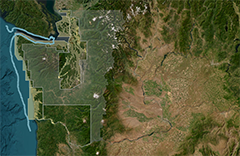 |
Click here to go to a webpage that provides information on Tsunami Design Zone Maps (WA-TDZ). Washington State building code requires that designers, engineers, and architects use the WA-TDZ to determine whether certain structures need to be designed for tsunamis.
|



